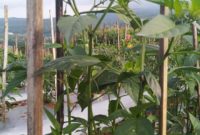A tank act as an irrigation storage system which is developed by constructing a small bund of earth or stones built across a stream. The water impounded by the bund is used for irrigation and for other purposes. Some tanks are built partly as dugouts and partly by enclosing bunds. Tanks are of varying size but most of the tanks are of small size and are built by individual farmers or groups of farmers. Tank irrigation is more suitable in the peninsular plateau area such as Andhra Pradesh (Including Telangana) and Tamil Nadu.
Andhra Pradesh is the largest state of tank irrigation which has about 29 per cent of tank irrigated area of India. About 16 per cent of the total irrigated area of the state is irrigated by tanks. The drainage areas of the Godavari and its tributaries have large number of tanks. Nellore and Warangal are the main districts of tank irrigation.
According to reports, Tamil Nadu has the second largest area which is over 23 per cent of tank irrigated area of India and about one-fifth of the total irrigated area of the state. Tanks comprise an important source of irrigation in the Karnataka Plateau, eastern Madhya Pradesh, eastern Maharashtra, interior Orissa and Kerala. Outside the Peninsular plateau, West Bengal, Bihar, Bundelkhand area of Uttar Pradesh, Rajasthan and Gujarat have tank irrigation.

Advantages of Tank Irrigation: Most of the tanks are natural and not expensive for their construction. Even an individual farmer can have his own tank. Tanks are normally constructed on rocky bed and have long life. In many tanks, fishing is also done. This supplements both the food resources and income of the farmer.
Drawbacks of Tank Irrigation: Major problem with tanks water storage is that tanks dry up during the dry season and fail to provide irrigation when it is needed the most. Silting of the tank bed is a serious problem and it requires de-silting of the tank at regular intervals. Much water is evaporated from the large expanse of shallow water and is therefore not available for irrigation. Tanks cover large areas of cultivable land. In many areas, other sources of irrigation have been adopted and the dry beds of tanks have been reclaimed for agriculture. Furthermore, lifting of water from tanks and carrying it to the fields is a tiring and expensive effort which discourages the use of tanks as a source of irrigation.
